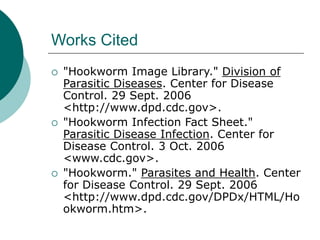Ancylostoma.ppt
- 1. Ancylostoma Duodenale and Necator Americanus By Marquetta Valdez
- 2. Some Facts…. Hookworms infect an estimated 1 billion people worldwide, mostly in tropical and sub-tropical climates A. duodenale and N. americanus are the two hookworms that infect humans A. duodenale is found in southern Europe, northern Africa, India, China, the Middle East, and the Americas N. americanus can be found in the southeastern U.S. and Australia
- 3. Life Cycle and Reproduction Eggs are passed in the feces and hatch into rhabditiform larvae in about 48 hours in the feces or in the soil A. duodenale N. americanus • Eggs are generally 57-76 µm by 35-47 µm and are oval shaped with a thin shell
- 4. Rhabditiform Larvae (wet mount)
- 5. Life cycle continued Juveniles feed on feces for about 3 days then molt into 2nd stage juveniles They molt again 5-10 days later into filariform larvae. Can survive 3-4 weeks outside host.
- 6. Life Cycle Infect humans by penetrating skin and then travel to the heart and lungs where they penetrate the pharynx and are swallowed. When they reach the small intestine they attach to the intestinal wall and feed on blood. Cutting plates in N. americanus Cutting teeth in A. duodenale
- 7. Life Cycle Worms molt again two more times to reach maturity A. duodenale adult males measure 8-11mm with females being 10-13mm N. americanus adult males measure 7-9mm and females measure 9-11mm Adult worms copulate and eggs appear in the feces in about 6 weeks (females can produce sever thousand eggs in one day) Cycle starts over again and adults live 1-2 years
- 8. Life Cycle
- 9. Transmission Filariform juveniles wait in soil or feces and wave back and forth to increase chances of finding a host Filariforms then penetrate the skin (usually hands or feet) Children, elderly people and people who work about contaminated soil are at high risk
- 10. Pathogenic Effects Asymptomatic until worms have already started multiplying Symptoms include: Irritation of skin at site of penetration Iron-deficiency anemia Abdominal pain Diarrhea Loss of appetite Weight loss Tiredness Difficulty breathing Cardiomegaly Irregular heartbeat Extreme cases include stunted growth and mental retardation
- 11. Diagnosis Stool samples showing eggs or actual worms Watching for symptoms
- 12. Control and Treatment Scientist are trying to develop a vaccine In some countries, infections aren’t treated because they are so common Drugs of choice are Albendazole, Mebendazole, and Pyrantel Pamoate
- 13. Prevention Wear shoes Monitor the disposal of humans feces
- 14. Works Cited "Hookworm Image Library." Division of Parasitic Diseases. Center for Disease Control. 29 Sept. 2006 <http://www.dpd.cdc.gov>. "Hookworm Infection Fact Sheet." Parasitic Disease Infection. Center for Disease Control. 3 Oct. 2006 <www.cdc.gov>. "Hookworm." Parasites and Health. Center for Disease Control. 29 Sept. 2006 <http://www.dpd.cdc.gov/DPDx/HTML/Ho okworm.htm>.













